Elizabeth Minchilli's Blog
December 6, 2024
VIA ROSA: Our New Tour Company
 Big News: We have just launched our new Tour Company: Via Rosa!
Big News: We have just launched our new Tour Company: Via Rosa!
As you all know, I’ve been leading food tours in Rome since 2012. What started as a way to pivot my writing career towards something more lucrative turned out to be the right road to follow. You probably don’t remember a time when food tours weren’t a thing, but back in 2012, I was one of the only people doing this in Rome. What seemed like a slightly weird idea back then (people would actually hire me to tell them what to eat?) turns out to have been a smart career choice.
I went from leading half-day market tours in Rome to hosting week-long food tours all over Italy. Along the way, the business has grown in ways I never dreamed possible. Not only have I been able to bring guests with me to explore the culture of food in places like Sicily, Puglia, Umbria, Tuscany, and Emilia Romagna, but I also have the best business partners in the world: my two daughters, Sophie and Emma.
Via RosaDuring all this time, the tour business lived online and was hosted on a page on my original blog (which you are reading right now.) We all decided that it was time for an upgrade to something more user-friendly with all the bells and whistles. We also decided that our little company had grown beyond simply being associated with my name or blog.
And so Via Rosa was born. Via in Italian means road, and Rosa was my mother-in-law’s name. Via Rosa sums up what all three of us think our new business embodies:
Traveling to Italy should be about discovering new roads that lead you to the traditions that hold our life here together. We firmly believe that much of that is inextricably tied to the culture of food. Who grows it, who makes it, who sells it, and, of course, who cooks it and places it in front of you at the table to share it with you. Just like Nonna.
There is history, love, and culture in every bite. In sharing these moments, we believe that everyone’s life will be richer. You will come away with a deeper understanding of the country, for sure. But also, we hope, you will get to know the fellow traveler sitting with you at the table. We are committed to the sense of community and understanding that exists when people share their stories while sharing a meal.
The New WebsiteYou can visit the new site here, and the tour page hosts our ever-expanding tour schedule. Our brochures now live fully online, so feel free to share the links with anyone you think would like to join us.
New tour announcements: As always, new tours will first be announced to Premium readers through my newsletter. A week later, they will be posted on the Tour page of the new website.
Guest hosts: Both Sophie and I continue to host tours all over Italy. As our business grows, we look forward to collaborating with friends and colleagues who have agreed to host their own week-long food tours in Italy. The weeks are expertly curated by Via Rosa, but you’ll get the chance to explore, cook, and eat with your favorite cookbook authors, radio hosts , health professionals, and online cooks.
Italy guides: I know many of you have missed my app Eat Italy, which I retired two years ago. In the meantime, Sophie has been sharing much of her knowledge on apps like Thatch and AmiGo, and many of my lists are scattered on my blog and in past newsletters. We are thrilled to announce that the new website has a dedicated guide section. We will be rolling out new guides all the time. We’ve also added a nifty PDF function so you can take the lists with you when you are on the road, either digitally or as print outs. If there are any specific guides you are looking for, just let us know in the comments below.
Blog: The blog section on the website will host posts about culinary adventures (for example, 36 Hours in Parma) as well as some of our favorite recipes we discover during our travels.
My Original Blog/Website
I can’t quite believe I’ve been regularly updating this blog since 2009. That’s 15 years!! 1215 posts!! While I used to update the blog 3 times a week, over the years, things have changed. Social media has become the way I share information, whether through words, images, video, or a combination of all three. Along the way, there were books, too. These days, my newsletter is where I share a lot of what I am thinking about. And so the blog got left by the wayside, and what has been pretty obvious for a while (my most recent blog post is from a year ago) is now official: I will not be updating the blog anymore. This is officially my last post. But don’t worry! It’s not going anywhere. The full archive will remain just how it is.
Follow us
We’ve set up new accounts for Via Rosa on Facebook, Instagram, and TikTok. We’ll be sharing information about the tours on these accounts but also creating posts that we hope will be helpful if you are heading to Italy (restaurant lists, travel tips, etc.), so please make sure you are following along so you don’t miss anything. (Sophie and I will of course continue to post on our own personal accounts)
Join us
The best part about growing our business is that we are able to host more tours and so meet more of you. Some of you have been following along on this adventure since before there was even an internet(!) and I thank you for from the bottom of my heart. More tours mean more fun, and Sophie, Emma and I look forward to sharing it all with you in person one day.
x, Elizabeth
(and Sophie & Emma)
The post VIA ROSA: Our New Tour Company appeared first on Elizabeth Minchilli.
February 27, 2024
A Week in Sicily with Odette Williams
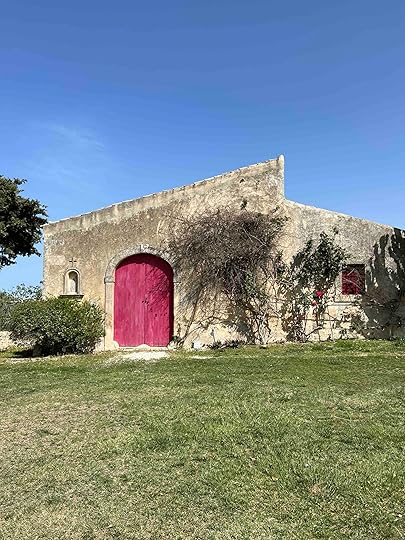
September 15-21, 2024
If you look on your bookshelf, you likely have one of Odette William’s books there. Simple Cake and Simple Pasta were both NY Times bestsellers. Australian-born Odette currently lives in Brooklyn and writes a weekly super fun column in the Wall Street Journal, Party Trick. Traveling with Odette is like being at one of her parties: she is the ultimate hostess.
Odette’s relationship with Italy is strong:
The moment I was old enough to travel, I packed my backpack and took off for Italy. The food and culture left a lasting impression. The minestrone in Florence, carbonara in Rome, and tortellini in Bologna. The emphasis on the quality of the produce and the simplicity of preparation became a north star for my own cooking. In 2021, I returned to shoot my New York Times Best Selling Cookbook, Simple Pasta, in Sicily. I became obsessed with this southern island. Eager to explore and learn more from local purveyors and food and wine experts, I’m thrilled to be hosting this tour in September. And I’d love for you to join me!
We are so happy that Odette has agreed to lead a group along with her as she explores Sicily. The tour has been curated by Sophie and I, and you will be accompanied by our colleague Salvatore, who is one of the best Sicilian tour guides we know.
You’ll be based in the romantic and ancient town of Ortigia and visit some of our favorite towns and villages while exploring the food, wine, and history of this part of Italy. The days will be full, and include activities such as visits to cheese makers, cooking classes, and olive oil tastings in ancient olive groves, sipping wine on the slopes of Mount Etna. It’s a side of Sicily that most visitors don’t access: You’ll be meeting and learning from the food producers, farmers, and cooks who form such an important part of the culinary heritage of this part of Sicily.
A few of the things you’ll be doing:Market walkCooking classGuided tours of Noto and OrtigiaVisit an almond farmVisit a winery on Mount EtnaGranita tastingDay at an organic ranchVisit to an olive oil plantationVisit an archeological park in Syracuseand more…Details:When: September 15-21, 2024
Where: We’ll be based in Ortigia (Siracusa)
Who: The tour is limited to 12 guests
What: The tour is 6 nights and 5 very full days, with trips in our private 20-seat bus. But don’t worry, you’ll also have some down time in Ortigia, to explore on your own.
How: For more information, including the pricing and the full itinerary click the link below:
The Culture of Food in Sicily with Odette Williams
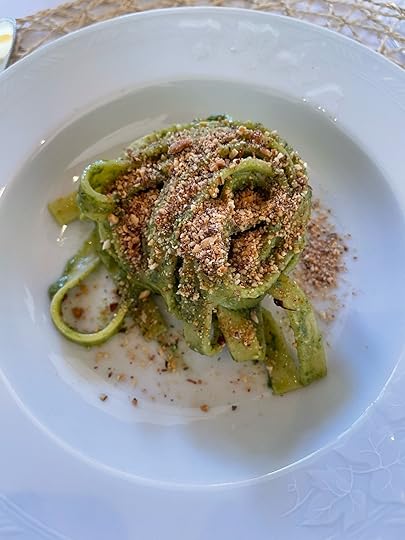
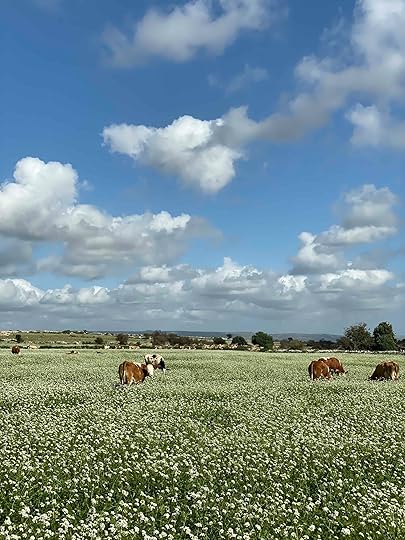
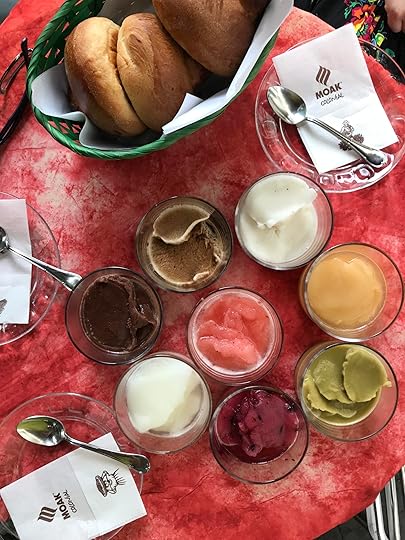
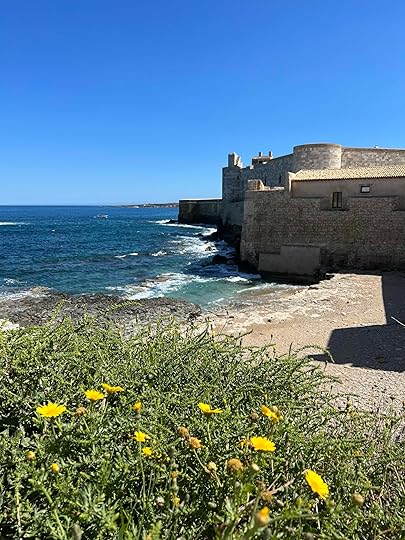
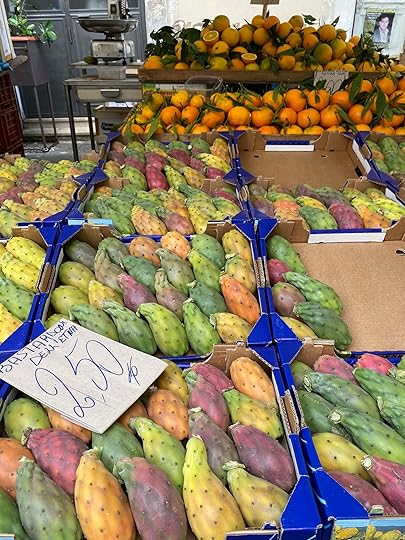
For more information or to book this tour please contact us at minchillitours@gmail.com
A Week in Puglia with The Amateur Gourmet
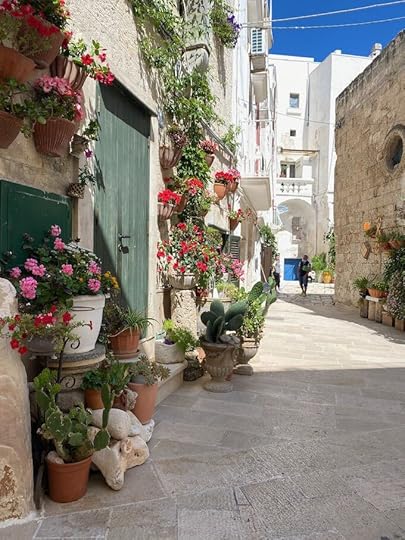
Due to increased requests to travel to Italy, and since there is only one of me and one of Sophie, we have recently launched tour collaborations with a few of our friends (like Adam Roberts a.k.a. The Amateur Gourmet) and colleagues who love Italy and food just as much as we (and you) do. We hope you will enjoy traveling to our best-loved places with them as much as we do.
It’s likely that you already know and follow Adam Roberts since his blog, The Amateur Gourmet, was one of the first food blogs out there. He began his blog in 2004 and has since gone on to write several cookbooks as well as contributing to publications like The LA Times, The Washington Post, and Food52. He also has a fantastic newsletter full of not just easily cookable recipes and entertaining tips but also his humorous take on life in the kitchen and elsewhere.
We are so happy that Adam agreed to lead a group along with him as he explores Puglia. Although not an ‘expert’ in Italian food, the ingredients and dishes of Italy play a starring role in his cooking and recipes and he is excited to share his enthusiasm with you.
You’ll be based in two of our favorite spots: Lecce and Monopoli. The days will be full, and include activities such as visits to cheese makers, cooking classes , and olive oil tastings in ancient olive groves. We’ll also be including stops in some of our favorite towns that are completely unique: Alberobello with its cone shaped trulli; Ostuni with its white washed buildings; Bari with it’s winding streets and pasta-making nonnas.
The tour has been curated by Sophie and me, and our trusted partner, Angelo (who is from Puglia) who will be the tour leader along with Adam.
The Culture of Food in Salento & Central Puglia with Adam Roberts: The Amateur Gourmet | October 13-19, 2024Fall is the perfect time to visit Salento (the southern part of Puglia) since the torrid heat of summer is past, but it’s still warm enough to go for a walk along the shore (which you’ll be able to do in Monopoli). You’ll be based in Lecce and Monopoli and visit some of our favorite towns (Ostuni, Gallipoli, Galatina, and Bari) as you explore southern and central Puglia’s food, wine, and history.
A few of the things you’ll be doing:
Welcome drinks and dinner in LecceMarket tour, cooking class, and lunchA day learning all about olive oilA guided visit and lunch in a cave in OstuniCheese and pasta-making class at a farmVisit the Unesco-protected, Trulli-filled, town of AlberobelloSeafood feasts in Monopoli and GallipoliVisit the pasta ladies in Bariand moreDetails:When: October 13-19, 2024
Where: You’ll be based in Lecce and Monopoli, staying in your private room
Who: The tour is limited to 12 guests
What: The tour is six nights and five very full days, with trips in our private 20-seat bus. But don’t worry; you’ll also have some downtime in Lecce and Monopoli to explore on your own.
How: If you’d like more information, including the pricing and the full itinerary, just click the link below to download the brochure:
The Culture of Food in Puglia with the Amateur Gourmet

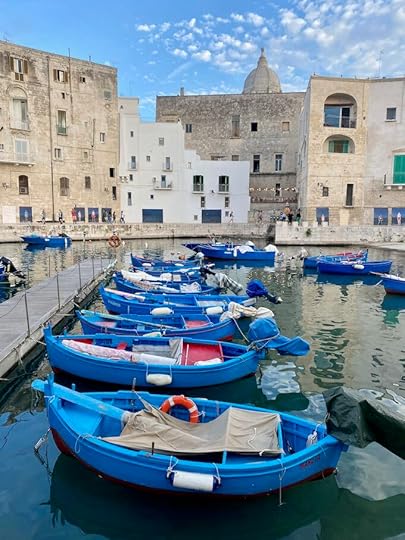
If you have any questions or would like to book this tour please contact us at minchillitours@gmail.com
November 29, 2023
pasta e ceci
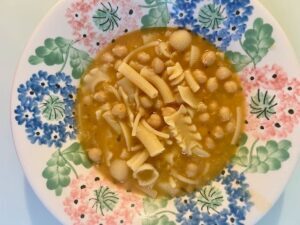
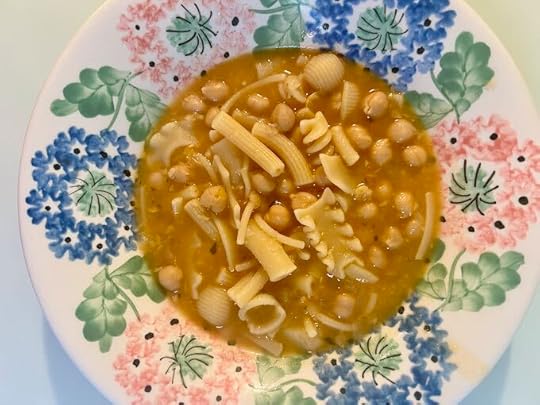 Since both girls are now living in Rome we are having more family dinners these days. I usually ask for suggestions about what to cook, and last week Pasta e Ceci was the winner. It’s not something I usually make, but I found a recipe (slightly adapted) from Rachel Roddy, which is super easy. So easy in fact that I think I’ll be making it more often.
Since both girls are now living in Rome we are having more family dinners these days. I usually ask for suggestions about what to cook, and last week Pasta e Ceci was the winner. It’s not something I usually make, but I found a recipe (slightly adapted) from Rachel Roddy, which is super easy. So easy in fact that I think I’ll be making it more often.
It’s basically a pantry recipe, except for the celery and onions. There is a good chance you have all the ingredients on hand already. Pasta e ceci is a cross between a pasta dish and a soup. You can make it as thick or thin as you’d like. In winter I tend to ere on the side of thick.
You can definitely use whatever pasta you have on hand. You can even use up leftover bits from bags you’ve already opened. Which is what it looks like I did here. But in Italy you can actually buy ‘pasta mista’ or a bag of mixed shapes. This one is by Faella but a lot of companies make it. I love the different textures and shapes all together.

1.5 liters of water
InstructionsDrain and rinse the chickpeas.Finely dice the onion and celery and cut up the potato in to small cubes. Heat the olive oil in aheavy-based pan and add the vegetables. Cook on low heat until softened, about 8 minutes.Add the rosemary, tomato paste and chilli and stir, cooking for about 3 minutes. Now add the chickpeas, salt, parmesan rind and water. Bring to a boil and let simmer slowly for about 20 minutes. Remove the cheese rind.Using an immersible blender puree it for a second. Just to thicken the soup a bit. Bring to a boil and add the pasta. Cook until done.Serve with extra grated cheese and a swirl of olive oil on topThe post pasta e ceci appeared first on Elizabeth Minchilli.
October 4, 2023
Pumpkin Flan
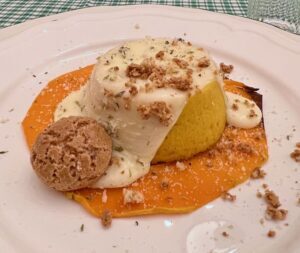

I love flans (called sformati in Italian) because they look fancy, taste delicious and are small enough to start a meal without filling everyone up. I recently shared a recipe for this zucchini version, which uses ricotta as the base. This pumpkin flan is much more northern Italian in feeling, with loads of parmigiano and just a touch of nutmeg. The sauce, made from Taleggio, is rich , luscious and a real treat.
If you don’t like the idea of the sweetness of amaretti cookies crumbled on top, you can skip it. But it really does taste good and gives it a nice crunch. It’s also very north Italian.
Also this would obviously make a festive start to any Thanksgiving feast.
PrintPumpkin FlanYield 4
Ingredients500 grams / 1 pound butternut squash100 gr parmigiano reggiano4 eggs1 tablespoon of heavy creamfreshly grated nutmegolive oilsalt and pepperButterFlourAmaretti cookies250 grams taleggio1 cup heavy creampinch of saltInstructionsPreheat oven to 200C/ 400FPeel the butternut squash, and cut four thin slices off the neck end.Cut the rest into chunks. You will only need 500 grams/ 1 pound.Toss the squash with olive oil, spread on a parchment covered oven tray and season with salt and pepper. Do the same with the four thin slices, making sure to keep them in tact.Bake until tender. The chunks should take about 20 minutes. The thin slices will cook much faster. Take them out after about 8 minutes.Turn the oven down to 180C/350FLet the squash cool then place in a food processor with the eggs, parmigiano and cream. Grate in a bit of nutmeg.Butter and flour 4 small ramekins.Place in the oven and cook for about 45 minutes until se
Cheese Sauce – This should be made right before serving.
Cut the cheese into cubes, eliminating the rind. Heat the cream in a small pan. Do not let it boil. Add the cheese and stir, so it melts. Let it cook until it becomes a bit denser. Taste and adjust for salt.To Serve:
Remove the flans from the ramekins by gently running a knife around the edge.Place a round of squash on a small plate and gently place the flan on top. Spoon some of the cheese sauce on top and then crumble an amaretti cookie on top. Garnish with another cookie.
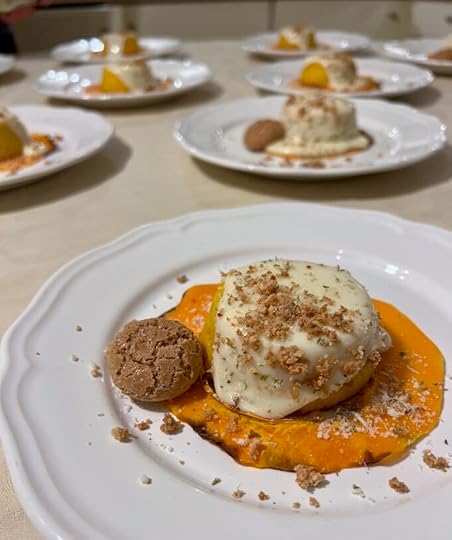
The post Pumpkin Flan appeared first on Elizabeth Minchilli.
August 14, 2023
Tomatoes + Bread
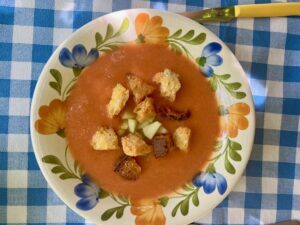
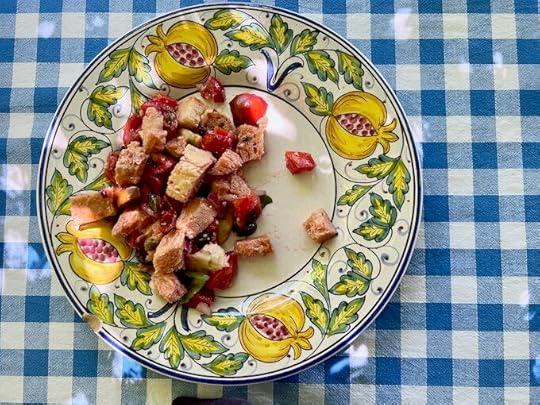 This is the time of year I can eat tomatoes for every meal, every day, every way. Luckily our vegetable garden is in over drive this year. Last year we got not one single tomato. This year? Our freezer is full of soup, sauce and just bags of cherry tomatoes to brighten our winter.
This is the time of year I can eat tomatoes for every meal, every day, every way. Luckily our vegetable garden is in over drive this year. Last year we got not one single tomato. This year? Our freezer is full of soup, sauce and just bags of cherry tomatoes to brighten our winter.
But in the meantime we are trying to go through as many fresh tomatoes as possible. One of the all time great pairings with tomatoes is of course bread. Of course just sliced tomatoes doused with olive oil and a slice of crusty loaf is great. But there are so many other recipes you should be making. Here are a few of my favorites that are on constant rotation.
Bruschetta is a no brainer, but this one adds ricotta to the mix.
Pappa al pomodoro is a Tuscan classic.
We’ve been having panzanella at least once a week.
Here’s another bread and tomato combo salad from Positano
Friselle : This southern Italian recipes combines twice baked bread (a kind of rusk) with tomatoes
Gazpacho: This recipe has become my new favorite. I take the opportunity to fry up fresh croutons from leftover bread to make it more of a meal.
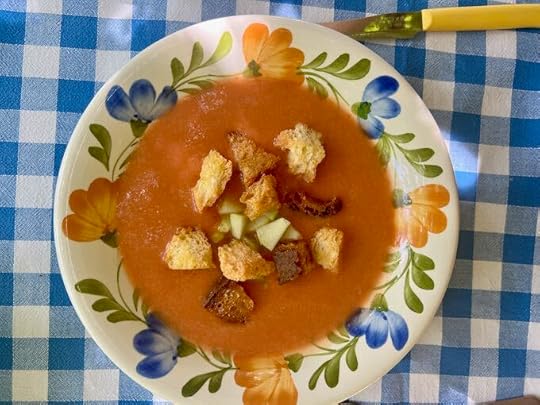
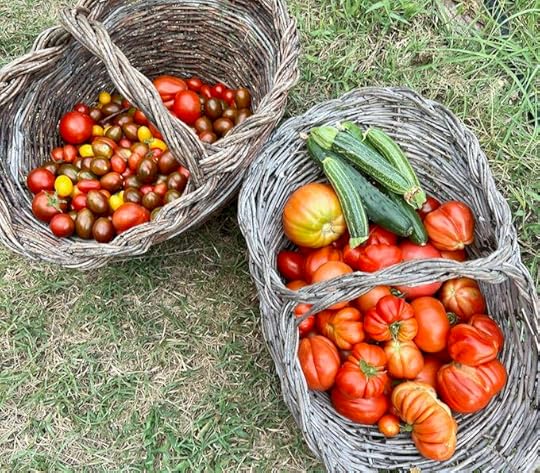

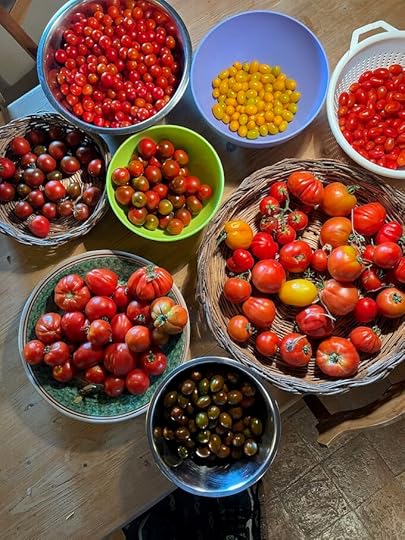

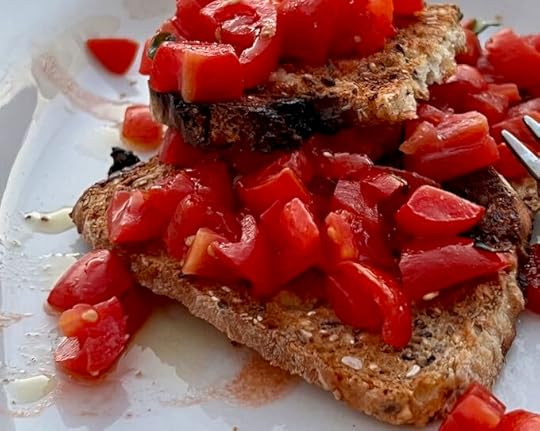
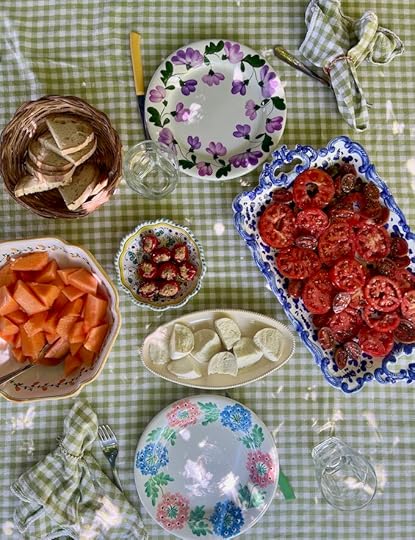
Hungry for more recipes? I’ve got lots in my latest book The Italian Table
The post Tomatoes + Bread appeared first on Elizabeth Minchilli.
Where to Eat in Puglia
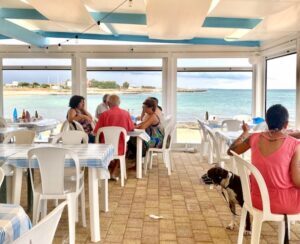
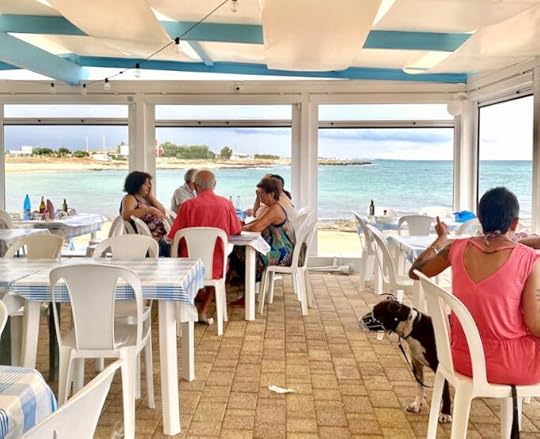 Today’s post is by Sophie:
Today’s post is by Sophie:
Puglia holds a special place in my heart. Since my father is from Bari, that city is almost like my second home. And in the summers we headed further south, on the coast down near Ugento. Then, in my twenties I started going down on my own, becoming close friends with people from the small village of Cutrofiano. I even spent two months working at a butcher there, so I literally got to know everyone in town.
I know Bari very well, since my father is from there. It’s the biggest city and the capital of Puglia. But since the region is long and narrow, the southern part, Salento, is completely different. These days I’m lucky enough to be able to spend a lot of time leading tours here. You’d think that when it comes to vacation I’d like to head somewhere else. But I’ll be spending a week there in August and I can’t wait.
The most common question I get is when is the best time to visit. March to June is one of the nicest times, in terms of weather. If you’re more beach-inclined obviously May/June is better beach weather. But March and April are perfect for seeing everything, especially if you want to avoid the heat and tourists. During our March and April tours we are often the only people in town, which I love.
GETTING YOUR BEARINGS: Puglia is actually a pretty big region, and exploring the whole region in just one week is close to impossible. However, if you manage to embrace the slow lifestyle of the locals and focus only on one or two specific areas without rushing through them, you are going to fall in love with this wonderful part of southern Italy and will want to come back for more. Think of Puglia as being divided into three parts: Northern, Central and Southern. Depending on how much time you have, pick a couple bases and take small day trips from there. It’s a good idea to pick a masseria as one of your bases: working farms that have managed to switch to the hospitality side of things as well, giving people a chance to experience (and eat) the local Apulian life
FOOD: The food in Puglia is some of the most diverse in the country, and for this reason it has become one of the biggest food destinations in Italy. The ideal weather conditions make Puglia one of the country’s biggest producers or fruits and vegetables, olive oil, wheat and seafood.
My Favorite Places to EatThis really isn’t a guide to the entire region, but just some of my favorite spots that you might otherwise miss during your time in Puglia. And if there is any place you’ve discovered on your travels, I’d love to hear about it in the comments below.
Pasticceria Andrea Ascalone
Galatina
This is said to be the place where pasticciotto was invented. The cream filled pastries come piping hot out of the oven. The 19th century interior is like stepping back in time and the owners incredibly sweet.
400 Gradi
Lecce
Pizza is not really a thing in this part of Italy, so finding an authentic Neapolitan pizzeria is a treat. Very high end ingredients, so it’s pricier than most, but so worth it. This is the place to head when you need a pizza fix.
Caffe Alvino
Lecce Piazza Sant’Oranzo
The most famous coffee bar in the center of Lecce. Make sure to try their caffe leccese, made with almond syrup; pasticciotto (breakfast pastry filled with custard); and my all time favorite: rustico leccese. This savoury puff pastry is filed with bechamel and tomato and is a flavor bomb!
Vardaceli
Castiglione
I love it when I come across and old fashioned family run trattoria. This one is at the most southern tip of Puglia and has traditional simple food.
Le Stanzie
Supersano
This old masseria (farm) is now run by the youngest generation of the family. Tables are spread throughout different rooms, some have fire places, others have strands of tomatoes hanging from the rafters. It’s incredibly beautiful in a very rustic way. Delicious regional food, most of which they grow themselves.
Osteria da Giuseppe
Ceglie Messapica
Very cute and simple restaurant in one of my favorite towns, Ceglie Messapica. Don’t miss the antipasti. After dinner I like going to the main square to people watch.
Quanto Basta
Lecce
Favorite cocktail bar in Lecce and one of the best in Puglia.
L’Orecchietta
Guagnano, Puglia
Set in a tiny town just north of Lecce, it looks more like a take away food place than a restaurant (and it is filled with locals either taking their lunch home or sitting and enjoying the food on their lunch break) They are also open for dinner, but it really comes to life for lunch, when the place really does fill up with locals. The whole family cooks in the back and takes great care in making you feel at home by taking extra good care of you, giving you advice on the surrounding area, chatting about recipes and ingredients. The menu changes daily, but there is always an abundance of local seasonal vegetables and fresh home-made pasta options
Le Macare (Alezio)
This place is a real gem. Don’t be put off by the location (on the side of a major road), away from any major city/town, because the food is amazing! The owners put an enormous amount of care in selecting the best possible ingredients for classic dishes from Puglia with a little twist. Try their mixed starters (they vary based on the season), and then enjoy one of their fresh pastas with seafood (these also change based on the catch of the day from nearby port town of Gallipoli)
Taverna del Porto (Tricase)
Set right on the seafront of the small port town of Tricase, this restaurant is on the higher side when it comes to prices, but the food and decor is on a higher level compared to many other places in the area, which explains the higher prices. Start with a mixed raw seafood platter (make sure to have a look at their fish counter as soon as you walk in too see what the catch of the day is). Their linguine aglio, olio e peperoncino di mare is exactly what I dream of when I crave a plate of pasta by the sea. As a main, try their mixed fried seafood platter, or perfectly cooked octopus with potatoes and bitter greens
Trattoria Iolanda (Lucugnano)
This place makes you feel like you are eating in your nonna’s kitchen. This is the place to try traditional dishes from southern Puglia like horse meat, ciceri e tria, seasonal vegetables and fried starters. In the summer, make sure to book a table outdoors to really get a feeling of Italian summer in a small town, where all the local families get together for long meals after a day at the beach. Make sure to get their mixed starters, and take a peak inside to see the owner roll out all the pasta by hand
La Puritate (Gallipoli)
These days it’s hard to find a traditional non-touristy restaurant in the center of Gallipoli, but this restaurant has managed to maintain it’s high quality food and traditional feeling over the years. La puritate is specialized in seafood (not a great choice if you are vegetarian), make sure to get their mixed starters, which change daily but may include mixed seafood salad, raw shrimps (a specialty in this part of the region), sauteèd mussels..etc and also make sure to ask for a portion of their prawns cooked in salt (gamberoni al sale) to add to the starters. They are cooked to perfection, and the waiter serves them table-side, flipping the prawns in a delicious olive oil-salt bath
Le Zie (Lecce)
These days it can be hard to find traditional restaurants that serve good food in Lecce, but this one is a must! They serve all the classic dishes like ciceri e tria, and horse polpette or involtini, in a homey environment (striped tablecloths, wooden chairs and tables, and a doorbell that rings every time a new customer comes in) which makes you forget you are in a restaurant, more like eating in somebody’s home.
Osteria del Tempo Perso (Ostuni)
If you only have one meal in Ostuni, it should be here. Set inside a cave, you can’t help but say ‘wow’ as soon as you step in. The ceramic plates are made by local artists, the service is impeccable, and the wine list is impressive. The food of course is the star of the show with an extensive menu which features a mix of both meat and seafood dishes. Try a few of their starters (a favorite is their wheat berries cooked in a cheese and truffle sauce, or their eggplant parmigiana), and a pasta dish (scialatielli with clams and zucchini blossoms or their Orecchiette con cime di rapa e mollica)
Al Pescatore (Bari)
Bari is known for its raw seafood feasts, and this is the place to try it out. It fills up with locals every single day of the week. Start with an antipasto misto (they will bring you an endless amount of raw + cooked seafood starters), and if you have room afterwards, head over to the fish counter with one of the waiters and have him help you choose something special to be cooked (they will tell you what options you have based on the fish you choose)
Bere Vecchie (Cisternino)
Cisternino is known for its small butcher shops that over the years have transformed into restaurants (you pick your meat at the counter and they cook it for you). Some of the most typical cuts of meat you can choose at the counter are the ‘bombette’: pork rolls stuffed with different cheeses, vegetables and cured meats, then put on a spit and roasted until crunchy on the outside and perfectly tender on the inside. Make sure to also order a side of fresh salad and whole potatoes cooked in coals. If you are into offal, try their ‘gnumaridd’: lamb innards rolled into little nuggets and grilled, they are a specialty of the area!
Mostofiore (Bari)
People in the city of Bari were incredibly excited when this place first opened, because there was a lack of natural wine bars in Puglia. They have an incredible selection from all over Italy, and their food menu changes all the time based on the season and what’s available. Some dishes on the menu may include crostini topped with different cheeses and cured meats, stewed Octopus, fresh oysters, Tuna tartare..etc Great place to have a lighter meal or pre-dinner aperitivo (The owner also owns BiancoFiore which is a fantastic restaurant nearby)
Il Cortiletto (Speziale)
When you get here, don’t be put off by the area (set on a main road outside the town center) or the very unassuming front, step inside and enjoy a meal in one of the best restaurants in Puglia. If the weather is nice, make sure to book a table in this restaurant’s inner courtyard, with its wooden tables, white-washed walls, and potted citrus plants, it makes the dining experience magical. The service is polite and knowledgeable, and the food is outstanding, with a focus on local dishes from central Puglia. Some of the standouts are their mixed antipasti to start (careful they are abundant!), and their home made pasta with ragù di braciole e polpette (meat sauce)
Al Gatto Rosso (Taranto)
Taranto is one of those gritty port towns that people ignore, but it is actually one of Puglia’s best kept secrets, filled with beauty, great food and incredible history (and one of the best archeological museums in Italy). Use this restaurant as an excuse to visit Taranto, and you will find yourself coming back time after time. Incredibly fresh and creative seafood dishes, which change daily based on the catch of the day. Some past dishes have been Spaghetti cacio e pepe con Gamberi rossi, Salad with poached prawns and peaches, raw seafood platter (raw mussels are a specialty in the area), all made with love by Agostino the owner, who you will see cooking in the kitchen
Ricciolandia (Savelletri)
If you only have one meal in Puglia, and want to eat by the sea, with locals, this is the place. More like a shack on the beach than a ‘real’ restaurant, it’ss set right on the seafront, plastic chairs and tables, with open walls which allow the fresh sea breeze to cool you down.This is where most locals come to have lunch on the weekends, they are known for their huge platters of sea urchins, it’s a magical experience being able to sit right on the sea on a sunny day while sipping on chilled wine, scooping out sea urchins with crunchy bread, and slurping on spaghetti with fresh clams and mussels
Antichi Sapori (Montegrosso)
You can either order a la carte or choose the highly recommended tasting menu (16 courses for 45 euros). Dish after dish comes out of the kitchen, each one better then the first. You will have an array of starters, a few pasta dishes, some meat, and lots of vegetables. The tiramisù and Cassata for dessert will be some of the best you have ever tasted. This is some of the most flavourful and colorful food in Puglia, with all of the products being sourced from local producers/farmers. Since it’s located in the very northern part of the region it might seem a little out of the way for most, but it’s a great place to stop for a lunch break while driving to/from Puglia and is always worth the trip if staying somewhere in the Northern part of the region.
Masseria Barbera (Minervino Murge)
Masseria Barbera is a hidden gem set in the middle of olive and wine groves, when you come here for a meal be prepared to completely forget about the rest of the world for a few hours. They grow most of their vegetables and make their own bread, olive oil and wine. Meat and cheese are sourced from local farmers. Order a few of their starters to share (menu changes almost daily, but you will most likely get some home-made focaccia, cheeses, vegetables), and then continue with one of their pasta dishes or slow cooked meats. Save room for dessert and their own home made digestifs (the chocolate and chamomile were memorable)
Baby DiCecca (Foresta Mercadante)
Vito and Roberta, a young couple from Puglia, recently opened up this ‘cheese bar’ set in the middle of a protected nature reserve in northern Puglia (Foresta di Mercadante). Vito’s family owns one of the best cheese shops in Puglia, so all the cheese comes from the shop in nearby Altamura (Caseificio di Cecca). You can either order a la carte or have their tasting menu which is an amazing option to experience a true cheese feast. Freshly baked and crunchy focaccia accompanies creamy burrata, mozzarella, scamorza, and then goes on to some more aged cheeses and tomato salad (if in season). For 180 euros you can also set up a cheese tour with the owner Vito. Starting the morning at his shop making cheese, and ending at Baby di Cecca for a cheese tasting lunch

Tomato Risotto with Burrata at Gatto Rosso in Taranto

Raw Seafood at Ricciolandia

Pasticiotto at Ascolane in Galatina

Seafood at Pescatore in Bari

Cheese tasting in the forest at Baby DiCecca
___________________________
If you’d like to join Sophie on one of her week long trips to Puglia, she’d love it! She leads tours to both the Central part of Puglia (Lecce and Monopoli) and to the Northern part, based in Bari. You can find the full schedule here or else send us or else just send us an email and we will be happy to send you the brochures.
(if the email link to receive a brochure doesn’t work, just email minchillitours@gmail.com )
The post Where to Eat in Puglia appeared first on Elizabeth Minchilli.
July 18, 2023
Sformatini di Zucchini
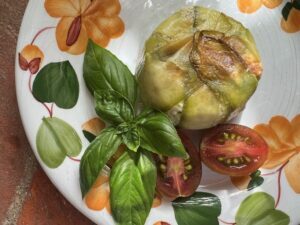
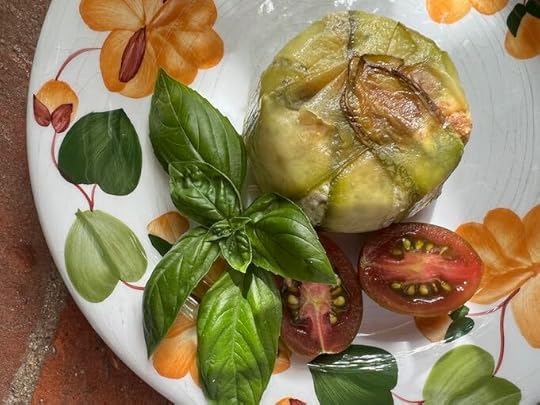 As part of my never ending decades long series for new zucchini recipes I present Sfomatini di
As part of my never ending decades long series for new zucchini recipes I present Sfomatini di
Zucchini. I make a winter version of this all the time, but somehow never thought it could be a way to use up my July zucchini crop.
I made these recently as the first course to a dinner party. Even though it was in theory too hot to turn on the oven, it was worth the 20 minutes of heat. They come together very fast and the only fiddly part is making the zucchini strips to line the ramekins.
I had planned to make a basil pesto to drizzle over it, but time ran out. Next time I will for sure.
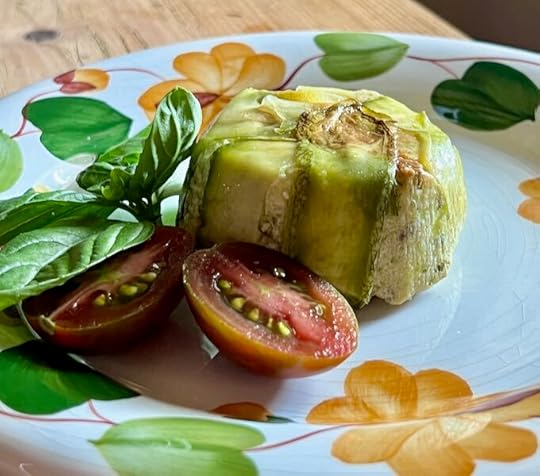
Yield 6
Feel free to play around with the vegetable. Obviously zucchini work best in the summer, but in the winter squash would be great. Also broccoli, cauliflower or even carrots.
Ingredients1/2 kilo of zucchini2 garlic cloves, peeled and choppedbig handful of fresh basil200 gr fresh ricotta1/4 cup grated parmigiano or mild pecorino1/2 tsp salt1/4 tsp freshly ground black pepper1 large egg3 tablespoons milk1 tablespoon cornstarcholive oilInstructionsUsing a peeler slice one of the zucchini into long thin strips and put them in a bowl. Gently toss with a bit of olive oil to coat and set aside.Dice the rest of the zucchini and saute in olive oil for about 10 minutes until tender and just starting to brown. Add the garlic and cook for another minute. Let cool for 10 minutes.Pre-heat oven to 180C/ 350FPlace the zucchini, ricotta, basil, cheese, salt, pepper, egg, milk and cornstarch into a food processor and blend until smoothOil six small ramekins and gently line them with the zucchini slices. Divide the mixture into the ramekins and fold up the zucchini over the top.Bake for about 25 minutes. Remove from oven and let come to room temperature. Gently invert them onto individual plates. Serve with a green or mixed salad on the side.The post Sformatini di Zucchini appeared first on Elizabeth Minchilli.
June 8, 2023
Vegetable Tart with Burrata
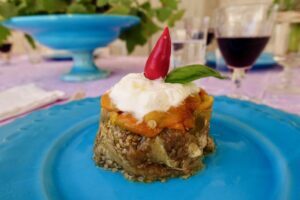
 I’m all about easy when it comes to summer cooking. The less I have to do the better. Vegetable Tart with Burrata (Tortino di Vedura con Burrata) is one of those back-pocket recipes I took home with me from Puglia while I was working on my book The Italian Table.
I’m all about easy when it comes to summer cooking. The less I have to do the better. Vegetable Tart with Burrata (Tortino di Vedura con Burrata) is one of those back-pocket recipes I took home with me from Puglia while I was working on my book The Italian Table.
I had this dish at the lovely Masseria Potenti where seasonal vegetables from the garden are center stage. Maria Grazia (the owner and head chef at the Masseria) realizes she doesn’t have to do much to the fantastic fresh produce she grows herself. At the same time she has a flair for presentation. Her Vegetable Tart with Burrata is really nothing more than roasted vegetables with burrata on top, but her way of presenting it is elegant yet not at all fussy. Also? The gorgeous ceramics don’t hurt.
Although it’s called a ‘tortino’ or little tart, it doesn’t have any crust. The recipe below calls for the best of summer vegetables (eggplant, zucchini, pepper and cherry tomatoes) but I’ve also done versions of it in the winter, subbing in roasted cabbage, onions and potatoes. A personal favorite is to use cubes of winter squash. It makes the perfect first course to any dinner.
This recipe calls for burrata, which is a Pugliese fresh cheese made of mozzarella and heavy cream. If you can’t find burrata you can simply mix some torn mozzarella with heavy cream and let it sit for several hours in the refrigerator.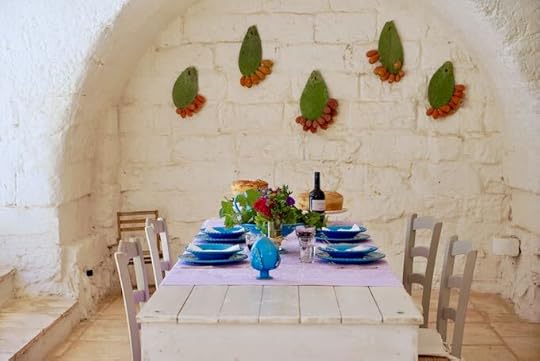
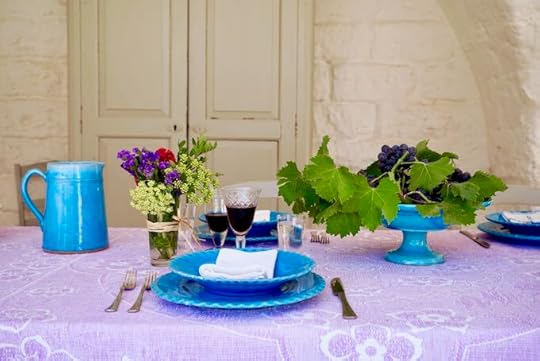
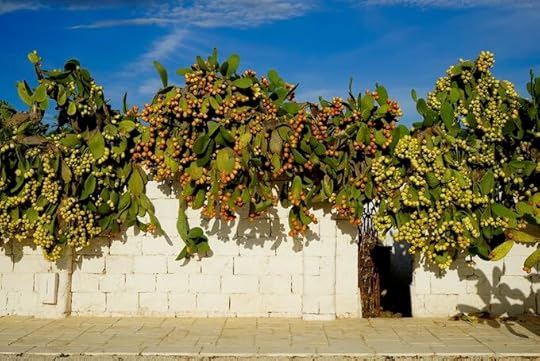
PrintVegetable TartIngredients1 red bell pepper, trimmed and cut into 1/2 inch wide strip1 medium eggplant, trimmed and cut into 1/2 inch wide strips2 medium zucchini, trimmed and cut into 1/2 inch wide strips2 red onion, trimmed and cut into 1/2 inch wide rings6 cherry tomatoes, but in half2 tablespoons of raisins1 cup basil leafs plus more for garnishsaltextra virgin olive oil1 pound of burrata8 ramekins or cooking rings8 small hot red peppers & basil leaves (optional for garnish)InstructionsPreheat the oven to 350°F/ 180°CDivide the chopped vegetables between two baking sheets so that they are spread out in one layer. Toss with olive oil, salt, basil and raisins. Place in oven and bake for 40 minutes, until the vegetables are tender. Remove and let cool.Using a 2-inch oiled cooking ring, place it on a small plate and layer the vegetables making sure to get some of each type of vegetable in each. Using your fingers or the back of a spoon, press down on the vegetables, to compact them. Gently lift up the ring.Finish by placing carefully placing 2 or 3 tablespoons of burrata on top of each tortino. Garnish, if desired with a hot red pepper and a basil leave. Finally swirl a bit of your best olive oil on top of and around the vegetables.
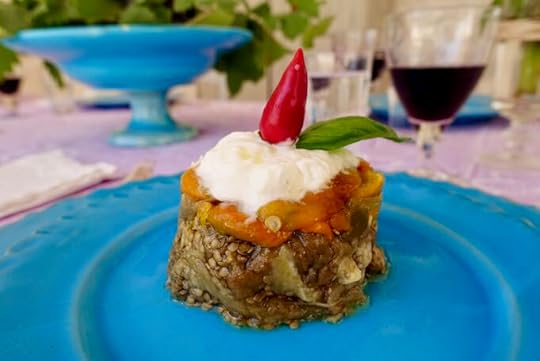
For more recipes from Puglia see my book The Italian Table: Creating Festive Meals for Family and Friends.
I also have several chapters on Puglia in my books Eating My Way Through Italy and Eating Rome
If these photos are making you want to travel to Puglia you can! If you’d like to explore Puglia with us (and visit places like Masseria Potenti) you can join us for one of our week-long food tours. You can find the entire schedule here.
The post Vegetable Tart with Burrata appeared first on Elizabeth Minchilli.
June 7, 2023
Tramezzini for A Cocktail Party

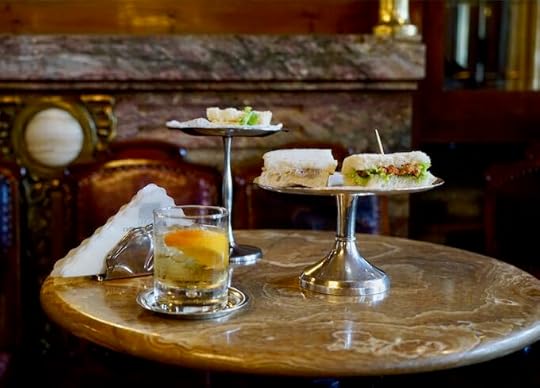 The following is a chapter that I wrote for my book The Italian Table. It got cut for space and I just realized I’ve never shared any of it. So here it is! Tramezzini make the perfect menu for a cocktail party.
The following is a chapter that I wrote for my book The Italian Table. It got cut for space and I just realized I’ve never shared any of it. So here it is! Tramezzini make the perfect menu for a cocktail party.
Tramezzini and I were not always friends. I blame this lack of openness to a little triangular sandwich on my father. While he first introduced me to pizza, pasta and other kinds of panini back in the 1970s when we first moved to Italy, tramezzini were not on his greatest hits list. And so I too scoffed at these odd little sandwiches which featured two of the food groups banned by my father: white bread and mayonnaise.
It wasn’t until my sister Robin had moved to Venice, to work at the Guggenheim museum, that I was converted and forced to see the error of my ways. Stopping for lunch one day her corner bar, Robin proceeded to order several tramezzini for us to share. I was horrified. White bread and mayonnaise? With things like preserved artichokes, tuna and eggs squished in between? What could be good about that?
Everything, as it turns out.
Since that fateful day in Venice I’ve made it pretty much my life’s goal to learn all about these tiny sandwiches. While I assumed they had originated in Venice, where they remain omnipresent, it wasn’t until years later that I learned the true history behind this Italianization of basic American ingredients.
The small delicate sandwich was actually invented in 1926 in Torino at a tiny jewel box of a bar, Caffe Mulassano. Hoping to make their cafe stand out from the rest, while searching for something that would pair with chilled vermouth that was the city’s speciality, the owner, Onorino Nebiolo looked back to the time he spent in America and decided to develop a sandwich (in itself very American) using the soft, packaged, white bread that he had grown found of there.
The small dainty panini were immediately popular, especially with workers from nearby offices, stopping by for a bite and a break, or after work for an aperitivo. Rather than simply layering cured meats and cheeses, Onofrio developed delicious fillings, using exotic ingredients like shrimp and lobster, or turning traditional Torinese specialites, like vitello tonnato, into panini fare.
The location of the bar (right in the center of town) and its over the top art nouveau decoration, made it a gathering place for the creative set as well. Writers and artists would gather at the marble topped tables to spend afternoons sipping vermouth and nibbling tramezzini. And it was one of those writers, Gabriele D’Annunzio who, during the fascist era, when Mussolini sought to ban any non-Italian phrases from use, re-babtized the Mulassano ‘sandwich’ as the ‘tramezzino’. A completely fabricated word, translated it means ‘caught in between’ which perfectly describes this panino.
Over the years the tramezzino has spread far beyond the city of Torino, making its way into bars all over northern Italy and down into the south as well. Along the way it has gone through a few changes. At some point the small postage stamp square that is still served at Mulassano became a much larger triangular-shaped panino. And the delicate amounts of fillings in Torino turned into tennis ball sized masses of mayonnsaise-based fillings that make the triangles bulge like some sort of swollen whale.
Me? I prefer the original, which are still painstakingly prepared each morning at Mulassano. When I’m in Torino (which is as often as I can arrange it) you can find me there not only at aperitivo time, but also for breakfast. And sometimes lunch too.
No where else are tramezzini given such attention and respect. First of all there is the ritual that surrounds it. The sandwiches are stacked on small plates, in a glass fronted cabinets, ready to be inspected and chosen. One of the funnest things to do is watch locals come in and discuss the merits of each and every one with the owners and anyone else who will listen, before settling on one or two. And then there is the ritual of presentation. Although we are really only talking about a sandwich here, it is treated with respect usually reserved for caviar or truffles. Each tramezzino is placed upon a doily topped pedestal riser before making its way to your flower-topped table, together with a small silver plated container for napkins, and the drink of your choice.
My inspiration for this dinner are the hours spent at this timeless cafe, nibbling on small sandwiches while being coddled by not just the food, but the setting and the traditions.
Canapès
Olives and Peanuts
Tramezzino con Insalata di Pollo – Chicken Salad Tramezzino
Tramezzino con Vitello Tonnato – Vitello Tonnato Tramezzino
Tramezzino con Insalata Russa – Russian Salad Tramezzino
Tramezzino di Tonno e Carciofi – Tuna and Artichoke Tramezzino
Tramezzino con Bresaola , Parmigiano, e Radicchio – Bresaola, Parmigiano and Radicchio Tramezzino
Tramezzino di Spinaci e Mozzarella – Spinach and Mozzarella Tramezzino
Tramezzino di Salmone e Arugula – Salmon and Arugula Tramezzino
Vermouth
Negroni
Negroni Sbagliato
Americano
Does anybody ever go to a cocktail party without thinking there should be enough food to make it into a dinner? Personally I consider cocktail parties just another way of throwing a dinner party, but playing by loser rules. Which makes turning this tramezzino-based menu into a de-facto dinner party super simple.
This is definitely a buffet kind of meal. Remember, in theory you’re throwing a cocktail party, not a dinner party. It’s up to your guests to decide how many tramezzini to indulge in. I’ve given recipes for six of my all time favorite types of tramezzini, but I’ve also given some alternatives, plus rules for inventing your own.
Each of the following recipes makes enough for 12 tramezzini. In general, figure on 2 to 4 per person, depending on how hungry people are.
TIMINGWhile you can certainly prepare the fillings ahead of time, don’t attempt to make your sandwiches until just before your guests are scheduled to arrive.
Hopefully you have decided to make your own mayonnaise. It really is luscious and adds an entirely different element. If you’ve never made mayonnaise before, please don’t attempt to make it for the first time on the day of your dinner. While making mayonnaise isn’t difficult, there are many ways it can go wrong, so please practice at least once before the big day. If you, or perhaps some of your guests, are wary of raw eggs (and anyone who is pregnant or has immune problems should avoid them) then you have my permission to use your favorite jarred mayonnaise. But in either case, be aware of not leaving the mayonnaise out of the refrigerator too long.
To assemble your tramezzini only make as many as you think will be eaten within an hour. Follow the directions below for cutting the bread and putting them together. Then place them on platter, covered with a slightly dampened cloth napkin. This will assure that the sandwich bread does not dry out. (If you’d like to make more, then wrap them in plastic wrap tightly and store them in the fridge).
The day before:
Prepare the mayonnaise
Cook and cool the chicken
Cook and prepare the Vitello Tonnato
Hard boil the eggs
Prepare the Insalata Russa
Cook the spinach
2 hours before your guests arrive:
Set the table
Prepare the chicken salad
Remove the vitello tonnato from the refrigerator
Remove the eggs from the refrigerator
Remove the spinach from the refrigerator
45 minutes before your guests arrive:
Prepare the tramezzini, being careful to keep them covered with a damp cloth until your guests arrive. Keep some filling and bread in reserve, to fill up empty platters later. There is nothing worse than a dried out tramezzino, so if you expect your party to go on over several hours, plan on refreshing your trays.
Prepare canapes if serving
Set out nuts and olives
If you’d like to recreate the fin-de-siecle vibe of Caffe Mulussano then get out your white tablecloth and starch it till it is crackling. Next, think height. If you have a serving dish on a pedestal this is the time to use it. Often called salvers, these footed platters allow you to arrange different types of tramezzini in an elegant way. Many people have them these days to use as cake stands, which work perfectly. If you only have one ask around. Everyone always has just one, so maybe you can borrow a few from friends to make up fun display.
Traditionally the tramezzini are not put on a plate, so just make sure you have enough napkins so your guests can hold the sandwiches daintily between their fingers without getting them dirtied. A staple of bars throughout Italy is a silver plated napkin holder, but barring that a stack of small cocktail paper napkins will do.
Silver: I know you probably don’t have a lot of silver serving pieces lying around, but if you do, this is the time to bring them out. Even if they are small and just to hold nuts or olives.
Flowers: one of my favorite touches in a bar full of favorite touches is the fact that Mulussano has a flower filled bud vase on every table.
WHAT TO DRINKThe traditional drink in Torino is vermouth. If you’ve never indulged, then you are missing out on one of life’s great pleasures. Many people think they don’t like vermouth, but they are probably having vermouth that has been opened ages ago, for some cocktail you wanted to try out. Then the poor bottle languished in the back of the cupboard, going bad. Because even though vermouth has a higher alcoholic content than wine, it still goes off, like wine.
Vermouth is a fortified wine (extra alcohol) that started out life in Torino in the 18th century as a kind of cure all tonic. Flavored with various spices, roots and herbs, it not only had a slightly medicinal taste, but was thought to be curative. The taste – complex and hovering between bitter and sweet – as well as the alcohol content (just high enough) soon made it popular as an aperitivo. Traditionally there are two distinct types of vermouth: pale and dry, and red and sweet.
While some of the big industrial beverage companies make some of the best known vermouths, it’s well worth seeking out smaller, artisinal makers. The only way to find out what you like is to taste as many as possible. That way you’ll find out what type and what brands you like. It’s a very personal taste. And keep in mind that Torino was, for years, part of France. So if you see interesting French vermouth, those will do just as well.
Many bars in Torino produce their own vermouth, each one slightly different. Mulussano’s is pale gold and hovers somewhere between sweet and dry, with distinct spicy notes. It is served, as in all bars in Torino, on the rocks with a slice of orange. I’m a particular fan of the vermouth made by Cocchi.
These days most people know vermouth as the ingredient of some of Italy’s best known cocktails. And the Negroni, Negroni Sbagliato and the Americano all use sweet red vermouth and all pair well with this menu.
RECIPESThe variations on the tramezzini theme are infinite. Whatever you can fit between two pieces of bread is ok. The following recipes are classics that also happen to be my personal favorites. Once you’ve read through the recipes you’ll begin to get the hang of it, and be able to create your own. Things to keep in mind:
Mayonnaise is an essential ingredient. If you don’t like mayonnaise, then choose another type of party.Keep things simple: Resist the urge to over stuff. Think ‘tea sandwich’ (in other words dainty).While I love the tiny square shapes at Mulussano, I’m not averse to triangles and that is the shape that is easiest to replicate at home.Bread: I thought about including a recipe for home made bread here, to use with your tramezzini but them I realized that since I would never make my own bread for what should be a rather simple party, I wouldn’t expect you to do the same. You can use either whole wheat or white bread.Canapés with ShrimpI love that Italian bars never give you an alcoholic drink without something to go with it. At Cafe Mulussano you can certainly order a tramezzino (they are not that big) but just in case they are too much to handle with your aperitivo, the waiter always brings out a small raised dish of canapés. Although they look elegant and fancy, in reality they are simply tiny open faced versions of their bigger tramezzini. But since they are canapés you can hold your your little finger while you eat them.
Canapés are almost as old fashioned a concept as tramezzini. So it makes sense that they take them very seriously at Caffe Mulussano. I love that these little tidbits (which are really no more than a paired down panino, made elegant) come to the table on their own mini pedestal.
Although you can call almost anything a canapé if you cut it in small enough pieces, here are my two favorites. They are darling and should be on their own special platter. I would suggest you place them around the room, not on the same table as the tramezzini.
Any of the fillings below can be turned into bite sized canapés. Just toast your bread first and then cut it into inch sized triangles. Top with a bit of mayonnaise and then just one other ingredient. My favorite by far are simply boiled tiny shrimp.
1/2 pound small shrimp, boiled and cooled
4 ounces of smoked salmon
6 slices of sandwich bread, crust removed
1 cup mayonnaise
Toast the bread slices and cool. Cut them into bite sized squares, measuring about 1 inch.
When ready to serve, top each square with a bit of mayonnaise (about 1/2 teaspoon) and one shrimp or a bit of smoked salmon. You can also use left over fillings from any of the other tramezzini recipes.
MayonnaiseIf you’ve never had homemade mayonnaise you are missing out on one of life’s great pleasures. You probably don’t put it up there with other great sauces like Bernaise or Hollandaise, because chances are you don’t even consider it a sauce. But it is, and one of the great ones.
Like all great sauces it is the emulsification of a few ingredients. Fat (oil) with protein (egg yolks) and just a bit of acid (lemon juice or vinegar.). The trick is having all your ingredients at room temperature, and taking your time.
For the following recipe I use mostly sunflower seed oil, but any other neutral oil will do. I also use some olive oil, but in this case I don’t use the most intense oil I have, but something a bit lighter. You don’t want the mayonnaise to overwhelm your other ingredients.
You can make the mayonnaise the day before, but if doing so, cover the top with a layer of plastic wrap, touching the surface so that it doesn’t dry out on the top. And of course, place it in the refrigerator immediately.
If you’re making a large quantity of tramezzini, and don’t feel like making your own mayo, that’s ok. (This party is supposed to be easy). Just make sure you buy the best quality mayonnaise that you can (organic if possible) and one that definitely uses eggs.
Makes 2 cups
3 egg yolks
1/4 cup of extra virgin olive oil
3/4 cup oranic sunflower seed oil
pinch of salt
2 to 3 tablespoons freshly squeezed lemon juice
1 teaspoon of white wine vinegar (optional)
Place egg yolks in a medium sized bowl. Using an electric mixer, begin to beat the eggs. When they have doubled in volume, and have become a light yellow, begin to add the oil
Add the oil very very slowly, in a thin stream. Don’t add too much at once, since you want the oil to emulsify, and not separate. Once you’ve added all the olive oil, keep beating, adding air into the mixture. When the mixture starts to look creamy and thick, add the lemon juice, and continue beating. The juice will thin out the mayo a bit, so you may have to add a bit more oil to thicken it up.
Add the salt, beat some more, and then add the vinegar, if using.
Taste and correct for seasoning. You may like yours more or less lemony.
Tramezzini di Pollo – Chicken Salad TramezziniThis is usually my go to tramezzino where ever I am. If a bar has insalata di pollo (chicken salad) then you can be pretty sure they are taking their tramezzini game seriously. Of course, there are good ones and bad ones. The following recipe results, I think , in the perfect ratio of chicken to lettuce to mayo to bread. The secret though, to making this sing, is to use dark meat chicken (always more flavorful) and cook it on the bone and with the skin on. Trust me on this one, it results in a tiny sandwich that packs a wallop of flavor. It will also help you understand why this is my favorite
Enough for 12 tramezzini
1 pound / 500 grams of chicken legs or thighs
1 carrot
1 stalk of celery
1/2 of a medium onion
2 teaspoons of salt
1 head of romaine lettuce, tender light green leaves from heart only
1-2 tablespoons extra virgin olive oil
salt
pepper
3-4 tablespoons of mayonnaise, plus more (about 1/2 cup) for bread
12 slices of good quality sandwich bread
Place the chicken pieces and vegetables in a pot large enough to hold them all and cover with cold water. Bring to a simmer, skimming off any foam that forms. Add salt and simmer for 45 minutes.
Remove the chicken pieces from the hot water and let cool completely.
Once cool, remove the skin and gently remove all the meat from the bone. Discard the bones and skin and, using your hands, shred the chicken into small pieces and place in a bowl. (You can make the recipe ahead up to this point)
In the meantime slice the lettuce into ribbons about 1/4 inch wide. Add 2 cups of the sliced lettuce to the chicken and toss with olive oil, salt and pepper to taste.
To assemble:
Carefully cut the crust off the bread.
Lay out six pieces of bread and spread liberally with mayonnaise.
Next add the chicken salad, spreading it out evenly to form a 1/4 to 1/3 inch layer on top of each piece. Now spread the the other six pieces of bread with mayonnaise and place mayo side down on top of chicken salad. Press gently into place and using a sharp knife, carefully cut the square into 2, along the diagonal, forming two triangles.
Place on a serving place and cover with a slightly damp, clean, cloth napkin.
Tramezzini con Vitello Tonnato – Vitello Tonnato TramezzinoVitello Tonnato is one of those old fashioned, northern Italian dishes that are hard to find in restaurants nowadays. You have to search out the kind of classic restaurant where the waiters still wear white jackets and just hope they have it on the menu the day you go. Or, you can just do what I do, and go to Torino to Cafe Mulussano and have it in tramezzino form. They always have it, since it is one their signature tramezzini and always has been.
This is not the kind of tramezzino you would whip up just for yourself at home (it does involve cooking a veal roast). But if you are throwing this entire tramezzini party, then go for it.
2 pounds / 1 kilo of veal roast (top round, trussed with string)
1 carrot, peeled
1 onion, peeled
1 stalk of celery
1 glass of white wine
1/2 teaspoon of peppercorns
2 cloves of garlic, peeled
1/2 cup white wine
1 teaspoon of salt
Juice from one lemon (optional)
For the sauce:
3 eggs
1 7-ounce can of olive oil packed tuna, drained
2 tablespoons of capers
4 anchovies
1/2 cup broth from the veal (or more if needed.
12 slices of high quality sandwich bread
6 tender lettuce leafs
Place the veal roast in a pot just big enough to hold it, along with the vegetables, white wine and salt. Add water to cover by a half inch. Bring to a simmer and, with the lid partially askew, cook for 1 hour and 20 minutes.
Take the pot off the heat and remove the roast to a plate. Let it cool completely. If you are preparing this the day before, cover with plastic wrap and place in refrigerator.
Reserve at least 1 cup of the broth (drained of the vegetables) for the sauce. You can freeze the rest of the broth for another use.
In the meantime prepare the sauce. Hard boil the eggs and let them cool completely. Peel them and add them, with the rest of the ingredients, including 1/2 cup of the broth. to a blender. Process until you’ve got a smooth sauce. It it seems too thick and stiff, you can add a bit more broth. The consistency should be like pancake batter. Taste and adjust for seasoning. Tonnato sauce is very personal. I like mine a bit lemony and so add some freshly squeezed lemon juice at this point.
Once the roast has completely cooled, cut into very thin slices, no more than 1/8 of an inch thick.
Prepare the veal to marinate overnight in the sauce: Spread about a 1/3 of a cup of the tuna sauce at the bottom of a serving platter. Place the veal slices on top, without overlapping too much. Spoon a bit more sauce to cover and then layer with the remaining veal. Repeat this until you’ve used up all the veal and the sauce. Cover the platter with plastic wrap and place in the refrigerator for 24 hours.
To assemble:
Carefully cut the crust off the bread.
Lay out six pieces of bread.
Spread a bit of the tuna sauce on the bottom of the bread. Place slices of veal on top, making sure to cover all of the bread. You may need 2 or 3 slices. But don’t over do it. You don’t want to build this up too thickly, but just cover the bread.Now add a bit more of the tuna sauce, using the back of the spoon to smooth it out.
Lay a lettuce leaf on top. Trim if you need to, but it’s ok if there is some lettuce sticking out of the side.
Carefully lay the remaining slices of bread on top. Press gently into place and using a sharp knife, carefully cut the square into 2, along the diagonal, forming two triangles.
Place on a serving place and cover with a slightly damp, clean, cloth napkin.
Tramezzini di Insalata Russa / Russian Salad TramezzinoIf tramezzini are all about the mayonnaise, then tramezzini filled with insalata russa is the the queen of the them all. Insalata Russa is the Italian version of the traditional Olivier Salad found in Russia. It’s basically boiled root vegetables held together with copious amounts of mayonnaise. If you think that sounds like just an excuse to eat mayonnaise, you’re right. If there is ever a time when you need to make your own mayo, this is it.
1 teaspoon of salt
1/2 pound of waxy potatoes, peeled and cubed into 1/3 inch pieces
1 large carrot, peeled and cubed into 1/3 inch pieces
1 cup fresh or frozen peas
1/4 cup of gherkin pickles, finely chopped
1/4 cup of pitted green olives, finely chopped
1 egg, hardboiled
1 1/2 cup of home made mayonnaise
12 slices of good quality sandwich bread
6 leafs of tender lettuce
Bring a small pot of water to boil, and add salt. Add the potatoes and cook them until tender, but be careful not to let them over cook. Using a slotted spoon, remove them and place in a small bowl to cool. Repeat this process for the carrots and peas, cooking each separately to control doneness. You’re looking for tender, but firm.
Place all of the vegetables together in a medium sized bowl along with the egg and add 1 cup of mayonnaise. Stir gently and if you like your insalata russa extra rich, you can add more of the mayonnaise.
To assemble:
Carefully cut the crust off the bread.
Lay out six pieces of bread.
Spread the insalata russa on top of the bread, using the back of a spoon to even it out. You should have about 1/3 inch of salad. Lay a lettuce leaf on top. Trim if you need to, but it’s ok if there is some lettuce sticking out of the side.
Carefully lay the remaining slices of bread on top. Press gently into place and using a sharp knife, carefully cut the square into 2, along the diagonal, forming two triangles.
Place on a serving place and cover with a slightly damp, clean, cloth napkin.
Tuna and Artichoke TramezziniThis is another one of my favorites, since anything with an artichoke in it has my name on it. This type of tramezzino is part of a group that pairs a protein (in this case tuna) with a vegetable (a preserved artichoke heart). Other typical combinations include mozzarella and tomatoes, bresaola and arugula (see below), spinach and mozzarella (see below), and hard boiled egg and tomato. Feel free to play around with various combinations, but never try to combine more than two ingredients or else you will lose the minimalist beauty of the tramezzino and verge into heavy waters of an American sandwich.
These types of tramezzini barely require a recipe, since you are just putting ingredients together. Just make sure you use the best ingredients possible (imported if you can).
1 8-ounce jar of artichoke hearts preserved in olive oil
1 7 ounce jar of tuna packed in olive oil, drained
1 cup of homemade mayonnaise
12 slices of good quality sandwich bread
6 lettuce leaves
Drain the artichokes from the olive oil (don’t throw away the olive oil, but use it on your next salad). If the artichokes are whole, but then into wedge-shaped quarters
Drain the tuna and place in a small bowl. Add 1/2 cup of mayonnaise, and using a fork, mix thoroughly, until the tuna is completely broken up and the mixture is a smooth paste.
To assemble:
Carefully cut the crust off the bread.
Lay out six pieces of bread.
Spread the tuna salad on top of the bread, using the back of a spoon to even it out. You should have about 1/3 inch of the mixture. Next place a few artichoke quarters on top. Lay a lettuce leaf on top. Trim if you need to, but it’s ok if there is some lettuce sticking out of the side.
Now spread the the other six pieces of bread with mayonnaise and place the bread mayo side down on top of lettuce leaf. Press gently into place and using a sharp knife, carefully cut the square into 2, along the diagonal, forming two triangles.
Place on a serving place and cover with a slightly damp, clean, cloth napkin.
Bresaola and Parmigiano and RadicchioBreasaola is the beef version of prosciutto. Not only is it leaner, it also has an intensely Earthy taste that makes it the perfect filling for tramezzini. While most bars will pair it with arugula, I like the combination of slightly bitter, wilted, radicchio.
1/2 of a small head of radicchio, sliced into 1/4 inch ribbons
3 tablespoons of extra virgin olive oil
2 teaspoons of Aceto Balsamico di Modena
salt
freshly ground black pepper
7 ounces / 200 grams of thinly sliced bresaola
3 ounces – 100 grams of Parmigiano Reggiano (whole, not grated)
1 cup of mayonnaise
12 slices of high quality sandwich bread ( I prefer whole wheat for this one)
Place the radicchio in a small bowl and add the olive oil, balsamic vinegar and salt and pepper. Toss well and let it sit for 10 minutes, to wilt a bit.
Using a vegetable peeler or a sharp paring knife, cut the parmesan into thin shavings and set aside.
To assemble:
Carefully cut the crust off the bread.
Lay out six pieces of bread and spread liberally with mayonnaise. Place slices of bresaola on top, making sure to cover all of the bread. You may need 2 or 3 slices. But don’t over do it. You don’t want to build this up too thickly, but just cover the bread. Next add a few shavings of parmesan cheese and then top with a small handful of the radicchio salad, spreading it out evenly.
Now spread the the other six pieces of bread with mayonnaise and place the bread mayo side down on top of the radicchio. Press gently into place and using a sharp knife, carefully cut the square into 2, along the diagonal, forming two triangles.
Place on a serving place and cover with a slightly damp, clean, cloth napkin.
Spinach and MozzarellaThis tramezzino is definitely on the comfort food side of the spectrum. While many tramezzini contain something a bit fresh and/or crunchy, this one is all about the softness and almost pure plainness of both the spinach and mozzarella. There are no big contrasts here, but the combination of fresh mozzarella with the bright green taste of spinach is a winner and somehow these are the first to disappear.
Many of the cheaper bars in Italy tend to use the prepackaged industrial mozzarella since it is drier and so doesn’t make the tramezzino soggy. Instead I prefer fresh mozzarella, but let it drain first.
2 pounds of fresh spinach
3/4 pound / 400 grams of mozzarella
1 cup of mayonnaise
salt
pepper
12 slices of good quality sandwich bread
Rinse the spinach several times in cool water to remove all the grit. Remove any thick stems, and then stuff the leaves into a large pot. Turn on the heat to medium, without adding any water. Let the spinach wilt completely then place it into a sieve to drain completely. When cool enough to handle, using your hands, squeeze all of the water out, forming it into a tight ball.
Place the cooked, cooled and dry spinach on a cutting board and roughly chop it.
If using fresh mozzarella (packed in water) remove the cheese from the liquid and slice it into the thinnest slices possible. Place it in a sieve over a bowl and let drain for at least 45 minutes.
To assemble:
Carefully cut the crust off the bread.
Lay out six pieces of bread and spread liberally with mayonnaise.
Cover the bread with a thin layer of mozzarella. Next cover with a thin layer of chopped spinach, using your hands to spread it out evenly. Season with salt and pepper.
Now spread the the other six pieces of bread with mayonnaise and place the bread mayo side down on top of the spinach. Press gently into place and using a sharp knife, carefully cut the square into 2, along the diagonal, forming two triangles.
Place on a serving place and cover with a slightly damp, clean, cloth napkin.
Salmon and arugulaThis is an extremely simple tramezzino you will see all over Italy, from Bari to Venice and at all the highway rest stops along the way. I think it’s because with very few ingredients you end up with something that is a bit more sophisticated than a normal panino. I mean, smoked salmon! It screams fancy. I tend to order this one as a breakfast tramezzino because (don’t judge) it’s the one that is closest to the bagels with lox that I miss from New York.
7 ounces / 200 grams of smoked salmon, thinly sliced
3 cups of arugula
1 lemon (untreated and organic) plus 1 tablespoon fresh lemon juice
2 tablespoons of extra virgin olive oil
salt
freshly ground black pepper
1 cup of mayonnaise
12 slices of high quality sandwich bread
Place the arugula leafs in a small bowl and add the olive oil, lemon juice and salt and pepper. Toss well.
Slice the lemon paper thin, into rounds and then half rounds. Remove any seeds and set aside.
To assemble:
Carefully cut the crust off the bread.
Lay out six pieces of bread and spread liberally with mayonnaise. Place slices of bresaola on top, making sure to cover all of the bread. You may need 2 or 3 slices. But don’t over do it. You don’t want to build this up too thickly, but just cover the bread
Next add a few rounds of lemon slices and then top with a small handful of the arugula salad, spreading it out evenly.
Now spread the the other six pieces of bread with mayonnaise and place the bread mayo side down on top of the radicchio. Press gently into place and using a sharp knife, carefully cut the square into 2, along the diagonal, forming two triangles.
Place on a serving place and cover with a slightly damp, clean, cloth napkin.
Some more ideas for tramezziniBaked Ham and taleggio or brie and lettuceHardboiled egg and tomatoGorgonzola, preserved mushrooms and lettuceProsciutto di parma and fresh figsSmoked turkey and red current jamCurried Egg Salad and ChutneyAnchovies and Butter (this is a classic, made without mayonnaise)Salame and sun dried tomatoes with lettuceCOCKTAIL RECIPESNegroniThe Negroni is my go-to cocktail. When I’m at home, it’s easy. When I’m out, it’s no-risk (a difficult drink to mess up). The cocktail dates to the early 1900’s, when a certain Count Negroni, a Florentine aristocrat, asked the waiter at Cafe Rivoire in Florence to up the ante in his Americano (see below). So he replaced the soda water with gin, and voila’!
There are a few ways to make a Negroni (shaken, stirred, in a cocktail glass, over rocks). Here’s my favorite:
1 ounce of Gin
1 ounce of Campari
1 ounce of sweet red vermouth (I prefer Rosso Antico )
Fill small rocks glass with ice. Add the gin, Campari and vermouth. Stir to mix. Garnish with orange or mandarin slice.
Negroni SbagliatoNegroni Sbagliato means Mistaken Negroni. And in this case the bartender makes the mistake of switching in a much lighter dose of prosecco in place of the gin.
1 ounce of Campari
1 ounce of Rosso Antico vermouth
2 ounces (more or less) of prosecco
Pour the Campari and Rosso Antico into a rocks glass. Fill with ice, and then top up with prosecco. Stir gently (you don’t want to make all the bubbles bubble away) and garnish with a slice of orange.
AmericanoThis drink seems to have fallen out of fashion lately. It is definitely the weaker cousin of the above cocktails and so, in terms of serving drinks at a party, you might want to consider it. It was originally called a Milano/Torino, since the Campari is from Milan, and vermouth is from Torino. At some point, around the 1900’s it was named after Americans, who seemed to order it a lot, while in Europe, drinking it up during prohibition.
1 ounce of Campari
1 ounce of sweet red vermouth
Soda water
1 orange slice
Pour the Campari and vermouth in rocks glass. Fill with ice, and top up with soda water and garnish with the orange slice.
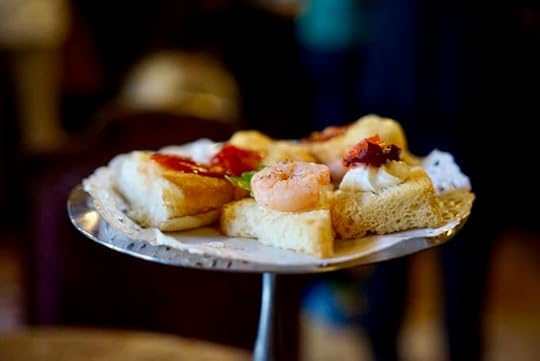
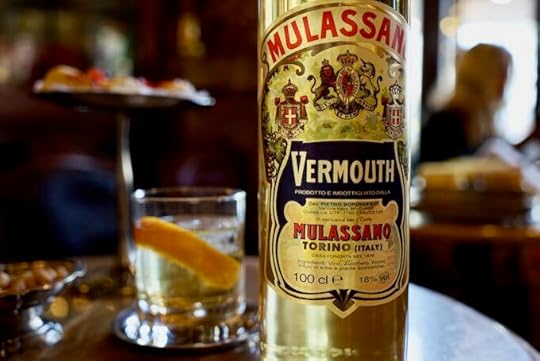
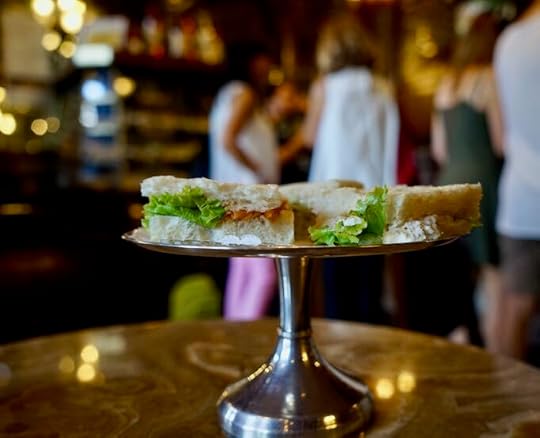

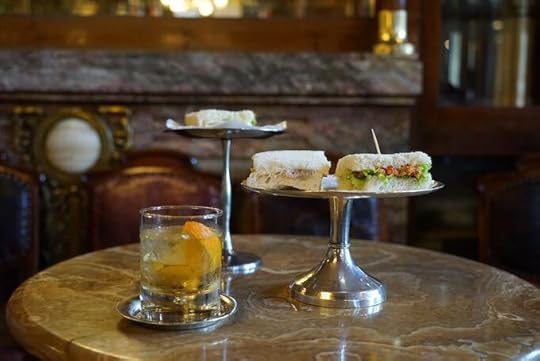
This post was originally written for my book The Italian Table: Creating Festive Meals for Family and Friends. The book contains 12 complete menus from all over Italy, with tips on how to set your table, drink suggestions and of course recipes.
I also have a lot more dinner party and menu ideas.
And if you’d like to join Sophie and me on our tours, we always include meals like the ones featured in this book. From farmhouses to palazzi and everything in between.
The post Tramezzini for A Cocktail Party appeared first on Elizabeth Minchilli.



